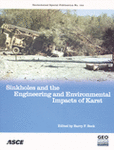Conceptualization and Simulation of the Edwards Aquifer, San Antonio Region, Texas
Publication: Sinkholes and the Engineering and Environmental Impacts of Karst
Abstract
Numerical ground-water flow models for the Edwards aquifer in the San Antonio region of Texas generally have been based on a diffuse-flow conceptualization. That is, although conduits likely are present, the assumption is that flow in the aquifer predominantly is through a network of small fractures and openings sufficiently numerous that the aquifer can be considered a porous-media continuum at the regional scale. Whether flow through large fractures and conduits or diffuse flow predominates in the Edwards aquifer at the regional scale is an open question. A new numerical ground-water-flow model (Edwards aquifer model) that incorporates important components of the latest information and an alternate conceptualization of the Edwards aquifer was developed. The conceptualization upon which the Edwards aquifer model is based emphasizes conduit development and conduit flow, and the model can be considered a test of one of two reasonable conceptualizations. The model incorporates conduits simulated as generally continuously connected, one-cell-wide (1,320 feet) zones with very large hydraulic-conductivity values (as much as 300,000 feet per day). The locations of the conduits are based on a number of factors, including major potentiometric-surface troughs in the aquifer, the presence of sinking streams, geochemical information, and geologic structures (for example, faults and grabens). The model includes both the San Antonio and Barton Springs segments of the Edwards aquifer in the San Antonio region, Texas, and was calibrated for steady-state (1939–46) and transient (1947–2000) conditions. Transient simulations were conducted using monthly recharge and pumpage (withdrawals) data. The predominantly conduit-flow conceptualization incorporated in the Edwards aquifer model yielded a reasonably good match between measured and simulated hydraulic heads in the confined part of the aquifer and between measured and simulated springflows. The simulated directions of flow in the Edwards aquifer model are most strongly influenced by the presence of simulated conduits and barrier faults. The simulated flow in the Edwards aquifer is appreciably influenced by the locations of the simulated conduits, which tend to facilitate flow. The simulated subregional flow directions generally are toward the nearest conduit and subsequently along the conduits from the recharge zone into the confined zone and toward the major springs. Structures simulated in the Edwards aquifer model that tend to restrict ground-water flow are barrier faults. The influence of simulated barrier faults on flow directions is most evident in northern Medina County.
Get full access to this chapter
View all available purchase options and get full access to this chapter.
Information & Authors
Information
Published In
Copyright
© 2005 American Society of Civil Engineers.
History
Published online: Apr 26, 2012
Authors
Metrics & Citations
Metrics
Citations
Download citation
If you have the appropriate software installed, you can download article citation data to the citation manager of your choice. Simply select your manager software from the list below and click Download.
